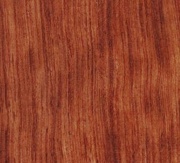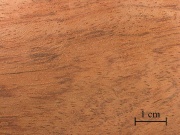Difference between revisions of "Bubinga"
(username removed) |
(username removed) |
||
| Line 31: | Line 31: | ||
== Authority == | == Authority == | ||
| − | * | + | * Ralph Mayer, ''A Dictionary of Art Terms and Techniques'', Harper and Row Publishers, New York, 1969 (also 1945 printing) |
| − | * | + | * Kribs, ''Commercial Foreign woods on the American market'' |
| − | * | + | * H.L.Edlin, ''What Wood is That?'', Viking Press, New York, 1969 |
[[Category:Materials database]] | [[Category:Materials database]] | ||
Revision as of 06:27, 24 July 2013
Description
A hard striped wood obtained from Guibourtia tessmannii and Guibourtia demeusei trees found in western Africa. Bubinga, or African rosewood, has either a light red, brown or violet background with evenly spaced pink or purple stripes. It has a medium texture and polishes to a high gloss. Bubinga is a decorative wood that is used for furniture, cabinets, veneer, pianos, and decorative items (handles, brushes, boxes, etc.).
Synonyms and Related Terms
Guibourtia tessmannii; Guibourtia demeusei; benge; African rosewood; eban; kevazingo (Gabon); amazakoue (Ivory Coast); essingang, nomele, ovoga, ian, omebaba, ogbonele, owong, nsu, simingan (Cameroons);
Other Properties
Color: purplish or reddish brown with stripes or mottling. Rings: distinct. Pores: diffuse, fine. Grain: faint. Rays: distinct. Hard, very heavy.
| Density | 50-57 ppcf |
|---|---|
| Molecular Weight | specific gravity = 0.91 |
Additional Images
Authority
- Ralph Mayer, A Dictionary of Art Terms and Techniques, Harper and Row Publishers, New York, 1969 (also 1945 printing)
- Kribs, Commercial Foreign woods on the American market
- H.L.Edlin, What Wood is That?, Viking Press, New York, 1969


